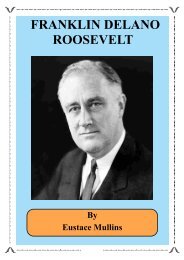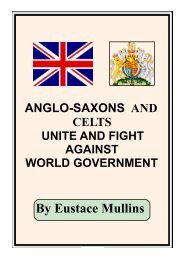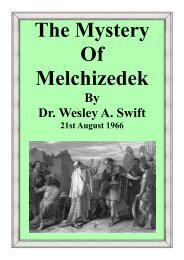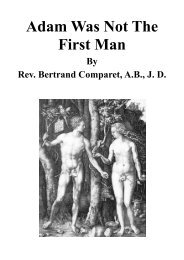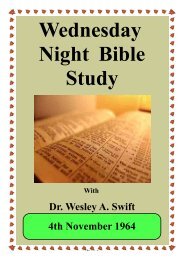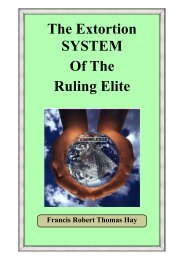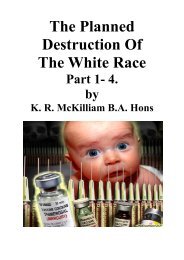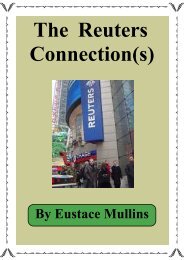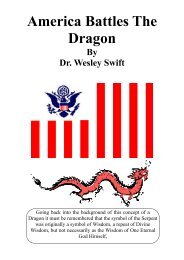Curse of Cannan - The New Ensign
Curse of Cannan - The New Ensign
Curse of Cannan - The New Ensign
Create successful ePaper yourself
Turn your PDF publications into a flip-book with our unique Google optimized e-Paper software.
some <strong>of</strong> the most sensitive court secrets <strong>of</strong> the Elizabethan Age; Tamburlaine is a play which<br />
exposes a Saturnian tyrant whose color was black (Canaanite), and a fulmination against<br />
dictatorial power. It may be his greatest work, but it has been shunted aside in favor <strong>of</strong> Dr.<br />
Faustus. This play openly portrays the process by which the demon-worshipping Canaanites, as<br />
agents <strong>of</strong> Satan, pledge themselves to the Devil in return for earthly riches and power. Marlowe's<br />
play takes up the power <strong>of</strong> incantations and chants, magical formulae, and shows Dr. Faustus'<br />
study, which is decked out with the planets and the signs <strong>of</strong> the zodiac. On the other hand,<br />
Shakespeare shows that he had been heavily influenced by cabbalistic works, such as Georgio's<br />
De Harmonica Mundi. His Merchant <strong>of</strong> Venice, although frequently denounced for its supposed<br />
anti-Semitism, actually is a powerful plea for racial tolerance.<br />
In more recent works, English scholars go to great pains to deny that Sir Francis Bacon ever had<br />
any connection with either the Rosicrucian movement or the Freemasons. Because these were<br />
highly secret organizations, it seems odd that these scholars could be so positive in their denials.<br />
Bacon, who had been given the title, Viscount <strong>of</strong> St. Albans, became the Lord Chancellor <strong>of</strong><br />
England. He was later removed from this <strong>of</strong>fice because <strong>of</strong> court intrigues led by Lord<br />
Buckingham. <strong>The</strong> Royal Society <strong>of</strong> London was founded thirty-four years after Bacon's death;<br />
in 1660, the Bishop <strong>of</strong> Rochester and the other founders paid <strong>of</strong>ficial tribute to Bacon's works<br />
as the basis <strong>of</strong> their Society.<br />
<strong>The</strong> Oxford English Dictionary <strong>of</strong>fers some notes on the cabbalists during this period: "Scott<br />
Monast. ... I used to doubt the existence <strong>of</strong> cabalists and Rosicrusians' thought the SubPrior."<br />
"1891, Rosie Cross. 'It is commonly held .... that there is a close connection ... between the<br />
Alchemysts and the Rosicrucians." W. Taylor, Monthly Mag. VIII 797, "<strong>The</strong> disciples ... have<br />
formed in churches an esoteric gnostic or illuminated order, rather than congregations." This<br />
quote is important because it shows that the Illuminati were penetrating the established churches.<br />
<strong>The</strong> 9th edition <strong>of</strong> the Encyclopaedia Britannica identifies the missing link between these groups<br />
as Ignatius Loyola, who founded the Jesuit Order on the Feast <strong>of</strong> the Assumption on April 15,<br />
1541 near Rome; this date is given by some authorities as 1534. He had formerly been a student<br />
at Salamanca; from 1520 on he was a member <strong>of</strong> an Illuminati sect in Salamanca called<br />
Alombrados; in 1527 he was tried by an ecclesiastical commission because <strong>of</strong> his membership<br />
in this sect; he was acquitted. In the Society <strong>of</strong> Jesus, he set up six degrees for advancement,<br />
which are the same as in Freemasonry; its doctrines are similar to those <strong>of</strong> the Jewish Mishnah.<br />
Four Lodges met at the Goose and Gridiron alehouse in London on June 24, 1717, to form the<br />
first Grand Lodge <strong>of</strong> England. Jacob Katz, in his book, "Jews and Freemasonry in Europe," says<br />
that the initial members included Mendez, de Medina, Alvarez, and Baruch, most <strong>of</strong> whom were<br />
Marranos. During Elizabeth's reign, the Rosicrucians had organized themselves as Masons,<br />
perhaps under Bacon's guidance. <strong>The</strong> Encyclopaedia Judaica says that the coat <strong>of</strong> arms <strong>of</strong> English<br />
Freemasonry was designed by Jacob Judah Leon Templo. 1717 was the year that the Hanovers<br />
ascended the throne <strong>of</strong> England. Under the leadership <strong>of</strong> George Ill's son, the Duke <strong>of</strong> Sussex,<br />
the rival lodges <strong>of</strong> "Ancient" and "Modern" were now joined. <strong>The</strong> Royal Society's members,<br />
who had paid homage to Bacon, joined the Masons through Rev. John Desaguliers, England's<br />
second Grand Master. Elia Ashmole was an important figure in the growth <strong>of</strong> English<br />
Freemasonry. Not only was he an important intellectual figure; he also organized the various<br />
mystery cults into the functioning system <strong>of</strong> Freemasonry. Together, Lord Acton and Ashmole<br />
controlled William Pitt's foreign policy, as well as the Royal Society <strong>of</strong> London, the precursor<br />
<strong>of</strong> the Royal Institute <strong>of</strong> International Affairs. Ashmole's name survives today as the prestigious<br />
Ashmolean Museum at Oxford.<br />
<strong>The</strong> growth <strong>of</strong> Freemasonry in Germany illustrates the power <strong>of</strong> the Canaanite force which<br />
brought the Hanoverian Kings to power in England. Its success focused on the career <strong>of</strong> Adam<br />
Weishaupt, born in 1748. At the age <strong>of</strong> twenty-two, he was elected to the chair <strong>of</strong> common law<br />
at Ingolstadt University; the post had been held by Jesuits continuously since 1750. He founded<br />
the Order <strong>of</strong> the Illuminati on May 1, 1776. <strong>The</strong> other founders were the Duke <strong>of</strong> Brunswick;<br />
Grand Duke Ernest <strong>of</strong> Gotha and the Elector <strong>of</strong> Hesse (whose transaction with King George III<br />
( Page 47)



